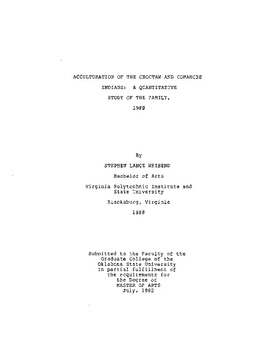| dc.description.abstract | The history of the United States, indeed all of the Americas, owes much of its uniqueness to the relationships that emerged where diverse races and cultures met and mixed. Particularly, as a consequence of miscegenation, the lines between red, white and black began to blurr. However, it was not just the colors of the people's skin which changed hue, but the complexion of the cultures as well. This study concerns itself with the relationship between two groups of North American Indians and the whites with which they came in contact. In particular this investigation will attempt to compare and contrast the experiences of the Choctaw and Comanche tribes and how they chose to acculturate to a society dominated by white Americans. The Choctaws were a strong and powerful tribe among the Indians of the Southeast; while the Comanches were known as the "lords" of the Southern Plains. The culture and experiences of both tribes were similar to those of the other Indian groups in their regions; thus the two present an interesting case study of how distinct Native American cultures approached acculturation. This study argues that the most important element in the successful transition of a society from one cultural system to another is the evolution of a metis or mixed blood class. Specifically among the Choctaws, a large class of mixed bloods made that tribe's acculturation much smoother by 1900 than that of the Comanches. This study traces the cultural changes in both tribes from their primitive cultures to the end of the nineteenth century. At that point the United States abruptly abolished the tribal government of both the Choctaws and Comanches. The first two chapters follow the two tribes from their aborginal condition to the end of the American Civil War. It was during this early period that we see both tribes confronted with the new and strange ways of the white man. It becomes apparent that the lifestyle and environment of the Choctaws and Comanches caused them to take radically different approaches to the process of accomodation. This early period was distinguised from the period after 1865 by the independence and autonomy of both tribes in picking and choosing wha they would accept from white society and how they would accomodate to it. After the American Civil War, the United States implemented its reservatopm system and became much more actively involved in the acculturation process. This period lasted until 1900 and ened with the allotment of tribal land in severalty and the dissolution of tribal governments. From 1865 until 1900 the two tribes maintained a distinct and separate identity from white society, yet they ceased to function as autonomous grops. While on their reservations both groups were under the scrutiny and discretion of the United States government, which institutied a series of programs desgined to speed up the Indians' acculturation and promote their successful assimilation into the greater white society. In order to see how far the two tribes had progressed in the process of change, and perhaps even to enlighten us as to key elements in these changes, the study utilized the United States 1900 Manuscript Census schedule. Because they formed the basic social level of both Choctaw and Comanche societies, household units were carefully examined. By studying the size, structure, households, as well as some and membership of the particulars about the individuals who comprised the household, it is possible to discern in what ways the two tribes differed from their primitive states, each other, and white Americans in general as of 1900. The information from the census on literacy, ability to speak English, and occupations as well as information on each individual's age, sex, place of birth and degree of Indian blood gave added insight as to how the Comanches and Choctaws had acculturated as social groups rather than merely as individuals. Instead of providing a traditional portrait of the experiences of a few - usually elite - individuals, the census gives a picture of the entire tribe at one instant in time. | |
